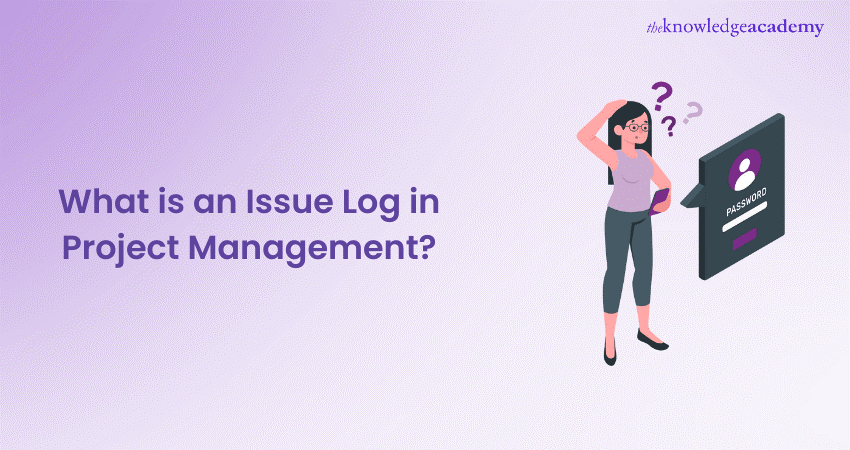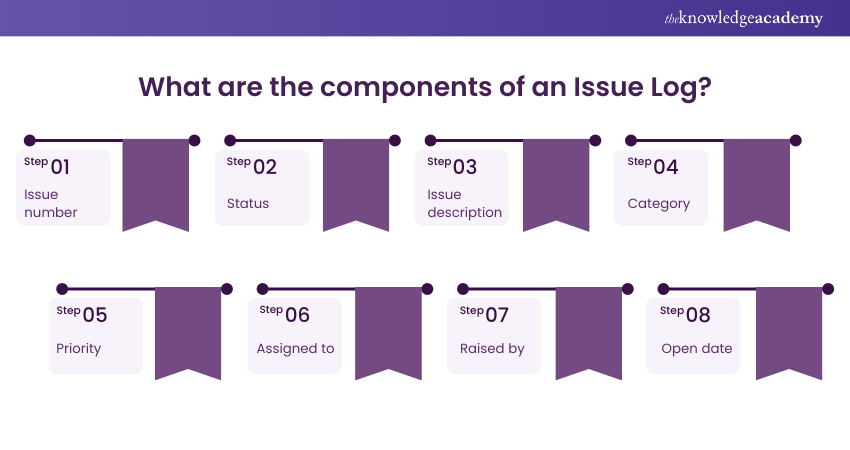We may not have the course you’re looking for. If you enquire or give us a call on 01344203999 and speak to our training experts, we may still be able to help with your training requirements.
Training Outcomes Within Your Budget!
We ensure quality, budget-alignment, and timely delivery by our expert instructors.

You probably know that an Issue Log is an essential Project Management tool. This is specifically because Project Management includesmultiple changes, Issues, and risks. To adequately cater to each of them, this tool helps Project Managers stay on top of their projects.
However, Project Managers may find it difficult to work on time if the Issue Log is not properly created. Thus, this blog will talk about this tool, its significance in Project Management, and how to make it.
Table of Contents
1) What is an Issue Log?
2) What are the components of an Issue Log?
3) How to create an Issue Log?
4) Conclusion
What is an Issue Log?
An Issue Log in Project Management helps to meticulously record and track every challenge that surfaces during a project's course. It's a detailed repository where Project Managers and team members document unexpected problems, roadblocks, or discrepancies that could impede progress. These Issues include a broad spectrum, which ranges from technical glitches and resource constraints to communication breakdowns and scope alterations. More than just a record-keeping tool, an Issue Log serves as an early warning system, allowing project teams to identify, assess, and prioritise problems swiftly. By doing so, it enables proactive problem-solving, preventing minor hiccups from turning into major setbacks.
Additionally, this tool promotes accountability by assigning specific owners to each Issue, ensuring that responsible parties are actively engaged in finding solutions. This systematic approach not only streamlines Issue resolution but also fosters a culture of transparency and collaboration within the project team.
What are the components of an Issue Log?
The components of an Issue Log can transform it from a plain document to a powerful Project Management tool. Each of its components has a unique purpose and can detect, manage, and resolve Issues. Some of its essential components are listed below:

a) Issue Number: If you want to monitor a problem, you should be able to distinguish it from others. Furthermore, you must understand that there will always be multiple Issues. Thus, giving number to your Issue can solve your problem.
b) Status: It is critical to record whether the Issue is open, in progress, blocked, or resolved. This is where you'll keep track of how you're getting it resolved.
c) Issue Description: As an important factor, you should write down the problem in detail. It may seem simple, but you should not have the same Issue tracked twice in your log. If you want someone to handle the Issue, you should explain what happened so they don't have to chase people down and delay their response.
d) Category: You must classify Issues as per the department or vendor, or by the Issue itself. These may vary based on the project or team.
e) Priority: You should prioritise having the time or resources to address every Issue. This can be done by filtering the log and focusing on the most essential project concerns.
f) Assigned to: It marks as an essential component because having no owner for the Issue can reduce its chances to get resolved. This component lets you identify the assigned team member to follow up on the Issue until it is resolved.
g) Raised by: This is distinct from the appointed owner, who will guide the Issue through the project and work to resolve it. This person was the first to notice it, and they should be included here because they may be able to help later by answering questions that lead to its resolution.
h) Open date: If you want a time frame, you must start from the day the problem was noticed. This can help you track the required time to resolve an Issue Log.
i) Closed date: You now have a firm schedule from start to finish, which might be useful if you need to look back at historical data while dealing with a similar Issue in a later project.
j) Comments: You should always have space to take down relevant information such as how the problem was resolved, whether it was related to another task, the possibility of recurrence, and so on.
Interested in unlocking your potential in Project Management? Sign up now for our Project Management Course!
How to create an Issue Log?
Making an Issue Log requires adhering to certain efficient procedures. The following steps can help you to create this effective Log:
1) Choose a program
An Issue Log can be created using a variety of technologies, including spreadsheets, databases, and Issue management software applications. A simple Excel spreadsheet may be used mostly for smaller teams. However, large teams that collaborate with other departments may benefit from access to more comprehensive problem-management tools. Using a program specifically intended for Issue management can also help you save time and optimise your workflow. You can compare different Log programs to see which one is ideal for your team.
2) Establish an ID system
Create an ID system once you've decided on the type of program you'll be using for your Issue Log. Many Project Managers just assign a number to each report, but you can also create unique codes. This allows you and your team members to keep track of each Issue and help them become more accurate and organised.
Learn how to elevate your project management skills with our Project Management Courses | Training & Certifications – sign up now!
3) Create categories
Next, you must think about the effective categories to group the reports you receive. For example, you can define categories based on the Issue type, its domain or the priority level. This can also help you swiftly filter reports and assign responsibilities. Once you've determined which categories are most useful, you must construct drop-down menus to increase precision and efficiency.
4) Identify key information
As an essential step, you should consider what additional critical facts are required to address difficulties. For example, you might want to know who is reporting the problem, when the complaint was submitted, and so on. You can also include a section for extra remarks to ensure you get all the necessary information. This might help your team come up with better solutions and communicate more effectively.
5) Automate alerts
Essentially, you should consider automating alerts to notify the appropriate people whenever a team member submits a report. Depending on the technology you choose to construct your Issue Log, you can automate notifications by changing your dashboard settings. For example, if someone reports a problem in the supply chain, the Supply Chain Manager may receive an automated email. This might help you guarantee that everyone is aware of the situation and that your team develops a prompt solution.
Advance your career with our Programme Management Black Belt Training - join us now!
Conclusion
Creating an effective Issue Log is an ongoing process that demands attention to detail, and a proactive approach to problem-solving. When executed meticulously, this tool becomes a dynamic tool that records Issues. Additionally, it drives the project toward successful completion by ensuring that challenges are addressed promptly and efficiently.
Empower your project leadership skills with our Project Management Black Belt Training. Join now!
Frequently Asked Questions

An Issue report in project management includes Issues that must be addressed formally. It is initially created when an Issue is captured. Later, it can be modified once the Issue has been reviewed and options for Issue resolution have been established.

A project team can identify and record Issues and provide their prompt and efficient solutions by using an Issue Log. Moreover, the team can complete the project on schedule and under budget.

The Knowledge Academy takes global learning to new heights, offering over 30,000 online courses across 490+ locations in 220 countries. This expansive reach ensures accessibility and convenience for learners worldwide.
Alongside our diverse Online Course Catalogue, encompassing 17 major categories, we go the extra mile by providing a plethora of free educational Online Resources like News updates, Blogs, videos, webinars, and interview questions. Tailoring learning experiences further, professionals can maximise value with customisable Course Bundles of TKA.

The Knowledge Academy’s Knowledge Pass, a prepaid voucher, adds another layer of flexibility, allowing course bookings over a 12-month period. Join us on a journey where education knows no bounds.

The Knowledge Academy offers various Project Management Courses, including the Microsoft Power BI Course, Tableau Desktop Training, and DAX Training. These courses cater to different skill levels, providing comprehensive insights into Digital Project Management.
Our Project Management Blogs cover a range of topics related to Issue Log, offering valuable resources, best practices, and industry insights. Whether you are a beginner or looking to advance your Project Management skills, The Knowledge Academy's diverse courses and informative blogs have got you covered.
Upcoming Project Management Resources Batches & Dates
Date
 Project Management Certification Course
Project Management Certification Course
Fri 17th May 2024
Fri 21st Jun 2024
Fri 19th Jul 2024
Fri 16th Aug 2024
Fri 13th Sep 2024
Fri 11th Oct 2024
Fri 8th Nov 2024
Fri 13th Dec 2024







 Top Rated Course
Top Rated Course



 If you wish to make any changes to your course, please
If you wish to make any changes to your course, please


